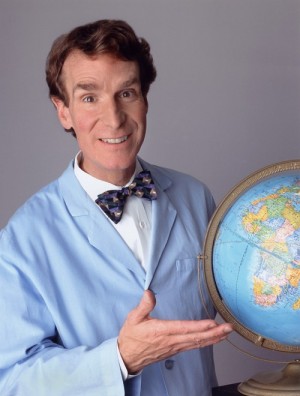How Bill Nye “The Science Guy” helped us manage our message
April 28, 2014
Getting your product into the hands of the right person at exactly the right time is the lynchpin of marketing. The same holds true for public relations (PR). Getting your message to the right publics at precisely the right time through the best delivery channel is a success.
Preparing a full-fledged public relations plan is the best way to start managing your message—whether it be a product launch, a new executive, a breakthrough or success of some sort, an event, and the list goes on. You identify all your publics. You tailor the message for each of your publics and choose the best delivery channels for each public. The timing is ready and you pull the trigger! Your perfectly crafted message will now reach all your targeted audiences and be received just as planned. You are a PR genius because your strategy worked and your company name is on the lips of powerful people in your industry and the media are all running with your story. Your phone won’t stop ringing with interview requests.
But wait, something happened and it’s not good. A monkey wrench has entered the scenario—completely out of your control. Your message is compromised for the worst, and it’s already out there in the public dialogue. What do you do?
You manage your message
Quickly get out in front of your identified publics through the delivery channels you selected for them and update your message. Call your reporters who showed interest with the new information, put a pop-up on the web page, and immediately start “talking” with people via social media. Post the update through all your social channels and watch for reactions and respond to them. Not only are you managing the message, you are managing expectations and pre-empting disappointment. Keep your stakeholders apprised of the situation as it evolves. This is NOT crisis communications — that is another blogpost entirely. This is actively managing your message in a dynamic and fluid environment.
The Bill Nye Effect

Here is a recent example of managing your message put into action by the
Strategic Marketing and Communications team
here at Chapman. A panel of distinguished individuals who advocate for science education were slated to give a group presentation at Chapman. The creative teams in marketing and public relations went to work to get the word out on this panel and promote it to all the right audiences, including the public at large. The word was out – the photographs of the panelists and their impressive backgrounds adorned collateral and press activities. People were showing interest in attending.
Three days before the date of the panel presentation, we received word that celebrity scientist Bill Nye had accepted an invitation to join the panel and would appear and present. The next 36 hours consumed us with managing our message to ensure all our publics knew of this wonderful news! Being such a huge name, and having just come off completing a nationally televised debate – his name was already in the news. We pulled out the stops to the extent that we could with such a tight turnaround. It was too late to do ads, but we could certainly manage our message by alerting the media and our followers on Chapman’s various social media outlets. The home page of
Chapman.edu
immediately had Bill Nye’s photo up with a blurb and a link to more info about the panel. It was a lot of quick work but we were excited to do it.
Then, the monkey wrench hit.
The day of the panel – which was slated to begin at 4 p.m. – we received word at 1:30 p.m. that Bill Nye was sick and would not participate! Now, more than ever, we HAD to manage our message. Since we had spent the past three days building up expectations for Bill Nye’s presence, if we didn’t manage the message, we would have a lot of disappointed publics to contend with and suffer tremendous bad will to our reputation. Even though we had nothing to do with Mr. Nye being ill – we/Chapman would pay the price for it unless we acted quickly. So we did.

The next two hours were spent alerting all of our publics through the various delivery channels about the change in Mr. Nye’s participation. Immediately we went to work crafting the language that would be the universal message: “NCSE panel update: We’ve just learned panelist Bill Nye will be unable to participate today due to illness. We apologize for the inconvenience; however, the event will continue as scheduled.”
Reporters were telephoned. A pop-up was placed on the Chapman home page with this language as well as on our social media feeds, which we monitored heavily. While some expressed disappointment – we largely were able to mitigate bad will with this pre-emptive strike. The media still attended and covered the event – after all, the panel was still a lineup of highly distinguished academics and we were careful to not take away from the panel’s prestige with all the Bill Nye messaging.

We got to the venue early and told people upon arrival at the door that we had learned a short while ago that Bill Nye would not be there due to illness. People still wanted to come in. In the end, the room was full with people even standing in the aisles! There was not one – but TWO – overflow rooms where more attendees could listen to the panel via audio. The distinguished panel gave invigorating and provocative presentations, which elicited many questions. As an event, it was a clear success.
Afterwards, three articles appeared in the local media on the event, as well as a blogpost which was shared through social media. All in all, not only was the event a success, but a test in managing the message proved a success. Remember to stay nimble, flexible and open to change—it’s the only constant.